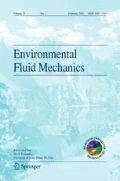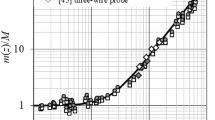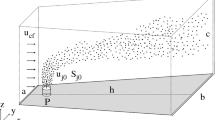Abstract
Entrainment characteristics of a pure jet and buoyant jets in a stably-stratified ambient are compared with the help of laboratory experiments employing simultaneous particle image velocimetry and planar laser induced fluorescence techniques. For the buoyant jet, two cases of background stratification are considered, N = 0.4 s\(^{-1}\) and 0.6 s\(^{-1}\), where N is the buoyancy frequency. Evolution of volume flux, Q, momentum flux, M, buoyancy flux, F, characteristic velocity, \(w_m\), width, \(d_m\), and buoyancy, \(b_m\) with axial distance is quantified that helps in understanding the mean flow characteristics. Subsequently, two different methods are used for computing the entrainment coefficient, \(\alpha\); namely the standard entrainment hypothesis based on the mass conservation equation and energy-consistent entrainment relation proposed by van Reeuwijk and Craske (J Fluid Mech 782:333–355, 2015). It is observed that entrainment coefficient is constant for the pure jet (\(\alpha _{pj}\approx\) 0.1) up until the point where the upper horizontal boundary starts to influence the flow. The entrainment coefficient for buoyant jets, \(\alpha _{bj}\), is not constant and varies with axial location before starting to detrain near the neutral layer. Near the source, \(\alpha _{bj}\approx\) 0.12 for both the values of N, while away from the source, N = 0.6 s\(^{-1}\) exhibits a higher value of \(\alpha _{bj}\approx\) 0.15 in comparison to \(\alpha _{bj}\approx\) 0.13 for N = 0.4 s\(^{-1}\). During detrainment near the neutral layer, \(\alpha _{bj}\approx\) – 0.2 for N = 0.4 \({\mathrm{s}}^{-1}\) and \(\alpha _{bj}\approx\) – 0.3 for N = 0.6 \({\mathrm{s}}^{-1}\). Importantly, close to the source, \(\alpha\) from standard entrainment hypothesis and energy-consistent relation are in reasonable match for pure jet and buoyant jets. However, far away from the source, the energy-consistent relation is ineffective in quantifying the entrainment coefficient in the pure jet and detrainment in buoyant jets. We propose ways in which the energy-consistent relation could be reconciled with standard entrainment hypothesis in the far-field region.
Article Highlights
-
Entrainment coefficient stays invariant for jets till the finite size of the domain in the axial direction disrupts this feature.
-
Entrainment coefficient for buoyant jets evolving in a stratified ambient varies with axial distance followed by detrainment beyond the neutral layer.
-
The existing entrainment relation performs reasonably well in the momentum dominated region but performs poorly when the finite size of the domain affects the flow for pure jet and when the flow is buoyancy dominated for the case of buoyant jets.















Similar content being viewed by others
References
van Reeuwijk M, Craske J (2015) Energy-consistent entrainment relations for jets and plumes. J Fluid Mech 782:333–355
Corrsin S (1943) Investigation of flow in an axially symmetrical heated jet of air. Wash, Wartime report
Davies POAL, Fisher MJ, Barratt MJ (1963) The characteristics of the turbulence in the mixing region of a round jet. J Fluid Mech 15(3):337–367
Crow SC, Champagne FH (1971) Orderly structure in jet turbulence. J Fluid Mech 48(3):547–591
Priestley CHB, Ball FK (1955) Continuous convection from an isolated source of heat. Q J R Meteorol Soc 81(348):144–157
Morton BR, Taylor GI, Turner JS (1956) Turbulent gravitational convection from maintained and instantaneous sources. Proc R Soc Lond Ser A Math Phys Sci 234(1196):1–23. https://doi.org/10.1098/rspa.1956.0011
Morton BR (1959) Forced plumes. J Fluid Mech 5(1):151–163
Wong DR, Wright SJ (1988) Submerged turbulent jets in stagnant linearly stratified fluids. J Hydraul Res 26(2):199–223
Turner JS (1986) Turbulent entrainment: the development of the entrainment assumption, and its application to geophysical flows. J Fluid Mech 173:431–471
Ellison TH, Turner JS (1959) Turbulent entrainment in stratified flows. J Fluid Mech 6(3):423–448
Princevac M, Fernando HJS, Whiteman CD (2005) Turbulent entrainment into natural gravity-driven flows. J Fluid Mech 533:259–268
Fischer HB, List EJ, Koh RCY, Imberger J, Brooks NH (1979) Chapter 9—turbulent jets and plumes. In: Mixing in inland and coastal waters. Academic Press, San Diego, pp 315–389. ISBN:978-0-08-051177-1
Bloomfield LJ, Kerr RC (2000) A theoretical model of a turbulent fountain. J Fluid Mech 424:197–216
Narasimha R, Diwan SS, Duvvuri S, Sreenivas KR, Bhat GS (2011) Laboratory simulations show diabatic heating drives cumulus-cloud evolution and entrainment. Proc Natl Acad Sci 108(39):16164–16169
Telford JW (1966) The Convective Mechanism in Clear Air. J Atmosp Sci 23(6):652–666
Papanicolaou PN, List EJ (1988) Investigations of round vertical turbulent buoyant jets. J Fluid Mech 195:341–391
Panchapakesan NR, Lumley JL (1993) Turbulence measurements in axisymmetric jets of air and helium. Part 1. Air jet. J Fluid Mech 246:197–223
Panchapakesan NR, Lumley JL (1993) Turbulence measurements in axisymmetric jets of air and helium. part 2. Helium jet. J Fluid Mech 246:225–247
Shabbir A, George WK (1994) Experiments on a round turbulent buoyant plume. J Fluid Mech 275:1–32
Duo X, Chen J (2012) Experimental study of stratified jet by simultaneous measurements of velocity and density fields. Exp Fluids 53(1):145–162
Mirajkar HN, Mukherjee P, Balasubramanian S (2020) Piv study of the dynamics of a forced plume in a stratified ambient. J Flow Visualiz Image Process 27:1
Talluru KM, Armfield S, Williamson N, Kirkpatrick MP, Milton-McGurk L (2021) Turbulence structure of neutral and negatively buoyant jets. J Fluid Mech 909:A14
Breda M, Buxton ORH (2018) Influence of coherent structures on the evolution of an axisymmetric turbulent jet. Phys Fluids 30(3):035109
Krug D, Chung D, Philip J, Marusic I (2017) Global and local aspects of entrainment in temporal plumes. J Fluid Mech 812:222–250
Pant CS, Bhattacharya A (2018) Evaluation of an energy consistent entrainment model for volumetrically forced jets using large eddy simulations. Phy Fluids 30(10):105107
Kaminski E, Tait S, Carazzo G (2005) Turbulent entrainment in jets with arbitrary buoyancy. J Fluid Mech 526:361–376
Oster G, Yamamoto M (1963) Density gradient techniques. Chem Rev 63(3):257–268
Mehta RD, Bradshaw P (1979) Design rules for small low speed wind tunnels. Aeronaut J (1968) 83(827):443–453
Adrian RJ (1991) Particle-imaging techniques for experimental fluid mechanics. Annu Rev Fluid Mech 23(1):261–304
Mirajkar HN, Balasubramanian S (2017) Effects of varying ambient stratification strengths on the dynamics of a turbulent buoyant plume. J Hydraul Eng 143(7):04017013
Matulka A, López P, Redondo JM, Tarquis A (2014) On the entrainment coefficient in a forced plume: quantitative effects of source parameters. Nonlinear Process Geophys 21(1):269–278
Peltier WR, Caulfield CP (2003) Mixing efficiency in stratified shear flows. Annu Rev Fluid Mech 35(1):135–167
Morton BR (1971) The choice of conservation equations for plume models. J Geophys Res (1896–1977) 76(30):7409–7416
Acknowledgements
Sridhar Balasubramanian is grateful for the funding support from Ministry of Earth Sciences (MoES) and Department of Science and Technology (DST). Partho Mukherjee and Harish Mirajkar acknowledge research scholarship from Ministry of Education, India.
Author information
Authors and Affiliations
Corresponding author
Additional information
Publisher's Note
Springer Nature remains neutral with regard to jurisdictional claims in published maps and institutional affiliations.
Rights and permissions
Springer Nature or its licensor holds exclusive rights to this article under a publishing agreement with the author(s) or other rightsholder(s); author self-archiving of the accepted manuscript version of this article is solely governed by the terms of such publishing agreement and applicable law.
About this article
Cite this article
Mukherjee, P., Mirajkar, H.N. & Balasubramanian, S. Entrainment dynamics of buoyant jets in a stably stratified environment. Environ Fluid Mech 23, 1051–1073 (2023). https://doi.org/10.1007/s10652-022-09893-y
Received:
Accepted:
Published:
Issue Date:
DOI: https://doi.org/10.1007/s10652-022-09893-y




